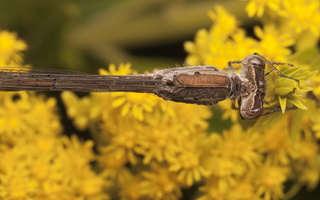- sort orderDefault
Photo title, A → Z
Photo title, Z → A
✔ Date created, new → old
Date created, old → new
Date posted, new → old
Date posted, old → new
Visits, high → low
Random - Google Map
- map
 home / Insecta · vabzdžiai / Odonata · žirgeliai / Lestidae · žaliosios strėliukės / Sympecma paedisca · sibirinė strėliukė
home / Insecta · vabzdžiai / Odonata · žirgeliai / Lestidae · žaliosios strėliukės / Sympecma paedisca · sibirinė strėliukė

Sympecma paedisca · sibirinė strėliukė
- siberian winterdamsel
- Sibirische Winterlibelle
- žieduotoji strėliukė, sibirinė strėliukė, sibirinė žiemkentė
- sibīrijas ziemasspāre
- straszka syberyjska, straszka północna
It is widespread from Central and Eastern Europe to Asia. Habitat: heavily overgrown shores of standing water bodies.
Sympecma paedisca and Sympecma fusca are similar in appearance: they’re typically light brown to orange-brown damselflies, with dark bronze-coloured markings on the dorsal side of the abdomen and thorax. Pterostigmas are long and brown and in the forewings closer to the tip than in the hindwings. Winter damselflies keep all four wings held together on one side of the body when at rest. Lateral sides of the thorax are usually silver gray in S. fusca and pinkish brown in S. paedisca but this characteristic can be unreliable especially with very fresh or very old individuals. Best way to tell the species apart is by looking at the antehumeral stripes. In S. fusca the lower margin of these stripes is straight while there’s a bulge on the underside of these stripes in S. paedisca.
Tamsi nugaros juosta su dantuku. Suaugėliai žiemoja. Rūšies arealas apima Vidurio ir Rytų Europą (aptinkama ir Lietuvoje) bei Aziją.
